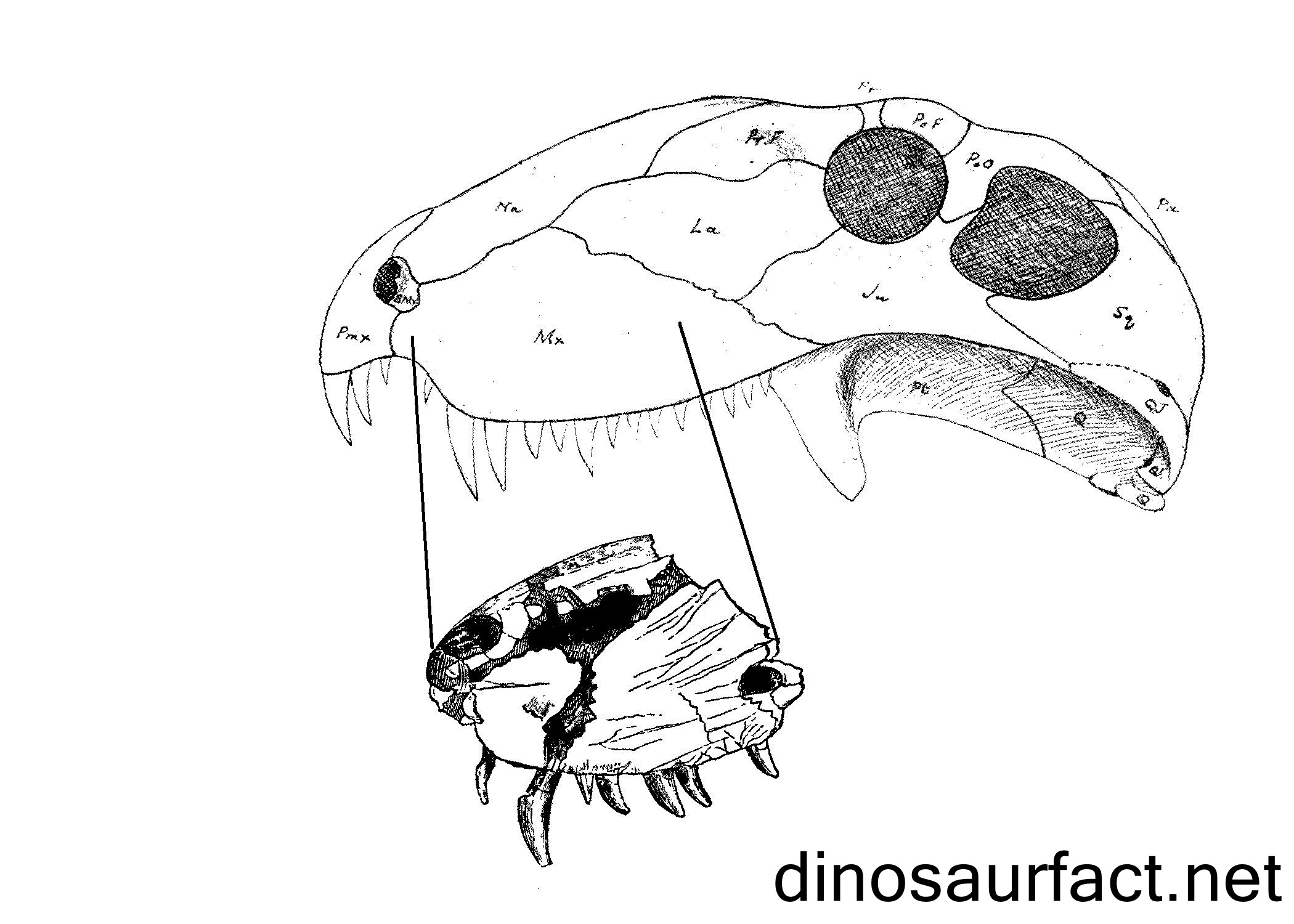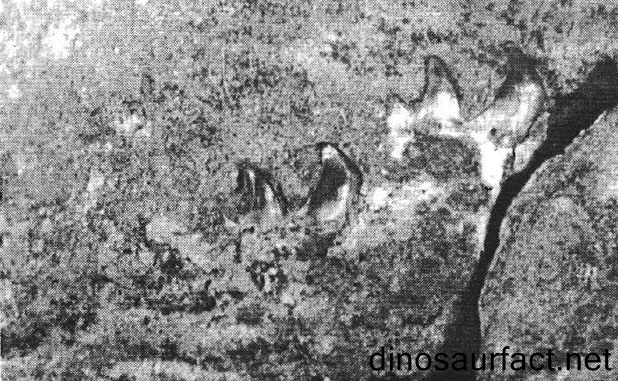 Click to visit the previous dinosaur bio
Click to visit the previous dinosaur bio
 |
|
 |
|
Kingdom: Animalia
Phylum: Chordata
Class: Sauropsida
Superorder: Dinosauria
Order: Saurischia
Genus: Rachitrema
 |
|
 |
|
 |
|

The Rachitrema was a marine reptile that was inexistence during the Upper Triassic period to the Lower Jurassic period. The timeline of its existence is judged to be about 202 to 195 million years ago. This lies right at the border of the Triassic and Jurassic periods, between the Rhaetian and Hettangian ages. It is presumed to be an ichthyosaur.
Very little is known about the Rachitrema because of the scarcity of its fossils. Its holotype consisted of a single bone and its paratype had only a handful of bones. Due to this, there was a debate about its taxonomic location for a very long time. The Rachitrema initially thought to be dinosaur. But upon in-depth investigation it was found that the fossils resembled aquatic reptiles more than they resembled terrestrial dinosaurs.
Even today, some paleontologists opine that the Rachitrema was a dinosaur. But most scientists believe it belonged to order Ichthyosauria.
The remains of the Rachitrema were discovered in France. It is unknown whether it was indigenous to the waters around France or it was present all around Europe. This is because its bones were discovered only from two places in France. It is possible that the Rachitrema resided in deeper waters and hence its remains were not easily fossilized near land. It is also possible that it was found in very small numbers.
Discovery of fossils
Only two set of remains have been ascribed to the Rachitrema. These were discovered by two different fossils hunters in the late 1880s. They were both found around the sea shores of France.
They were first examined by scientist Henri Emile Sauvage.
Nature of fossils
The remains of the Rachitrema were in a very poor condition. They comprised of very few bones in total. Most of these bones were incomplete as hence not of much help to classify the remains.
The fossils included a few broken pieces of vertebrae. These probably belonged to the cervical region. These were probably the most diagnostically pertinent bones in the whole of the fossils. The vertebrae were by no means intact and had many processes missing.
Age of fossils
The bones of the Rachitrema were believed to be from the late Triassic period. They were found in locations were Triassic and Jurassic fossils were found together.
Etymology
The name ‘Rachitrema’ is an amalgamation of two words. The prefix ‘rachi’ is derived from the Greek word ‘rachios’. It translates to ‘spine’ in English. The suffix ‘trema’ has Latin origins. It means ‘opening’ or ‘hole.’ Thus, the name ‘Rachitrema’ roughly translates to ‘a spine with holes’. This name was chosen for the fossils as they included a few incomplete vertebrae.
The christening of the Rachitrema was done by H. E. Sauvage.
Classification
- The classification of the Rachitrema has been a long process. Its remains were discovered in the year 1882. At that time, a few marine reptiles were discovered but they were not understood well. And the fossils of the Rachitrema were limited, making the classification even more difficult.
- Sauvage was convinced that it was a dinosaur; although he could not determine which family did it belong to. He gave it a species name as well, the Rachitrema pellati.
- A few years later, scientist Franz Nopsca determined that the Rachitrema was a basal sauropodomorph related to the Anchisaurus.
- Karl von Zittel was of the opinion that it was related to the Zanclodon or the Megalosaurus.
- Friedrich von Huene recognized that the remains of the Rachitrema did not match dinosaur remains. He believed it was an ichthyosaur which was similar to the Shastasaurus.
- But as the remains were more thoroughly examined, it was found out that they may not be as large as the Shatasaurus. Thus, the Rachitrema cannot yet be classified beyond order Ichthyosauria.
Ichthyosaurs
Ichthyosaurs were a group of large marine reptiles that were inexistence almost all throughout the Mesozoic era. They were carnivorous and were one the most important predators of the Triassic and Jurassic oceans along with Nothosaurs, plesiosaurs and mosasaurus.
Ichthyosaurs differed greatly in terms of morphology. All of them were adapted for a marine environment and had streamlined bodies. But there existed other differences between individual.
The primitive members lacked a dorsal fin while the evolved members invariably had one. Their snouts had many different shapes and sizes.
Many ichthyosaurs were viviparous, i.e. they gave birth to live neonates. It is clear that they have originated from land dwelling reptiles.
Henri Emile Sauvage and Friedrich von Huene
- H. E. Sauvage was a French scientist. He was born in the year 1842.
Sauvage was highly interested in the study of fish and other aquatic creatures. He had authored many articles about the same for scientific magazines.
Sauvage was unconvinced that the Rachitrema was a marine reptile. But he eventually deferred to von Huene and acknowledged that it remains looked more like aquatic organisms.
- Friedrich von Huene was a famous German vertebrate paleontologist. He revolutionized the taxonomic classification of dinosaurs in the beginning of the twentieth century.
von Huene had examined and renamed more dinosaurs than any of his contemporaries. He is also credited with the discovery of the Plateosaurus.
He never ceased working even after retirement and passed away in his home town of Tubingen at the ripe old age of ninety four.
Physical features and habitat
The Rachitrema has not been defined beyond order Ichthyosauria. But based on its initial classification, it is believed that the Rachitrema was a moderately large creature. Its exact dimensions cannot the gathered based on available fossils.
It is accepted today that the Rachitrema was aquatic. But it is impossible to determine whether it resided near the coast or in deeper waters.
Related species
The Rachitrema was present in the Triassic period. Thus it was among the lesser evolved ichthyosaurs. Scientists have been unable to comment any further on its familial relationships.
Concluding notes
The Rachitrema was believed to be a dinosaur when it was first discovered. Some scientists hold that opinion even today, but they are greatly outnumbered by those which believe it was an ichthyosaur.
Many bones which were originally ascribed to the Rachitrema are reckoned unclassified remains today. Due to this, it cannot be classified beyond order Ichthyosauria unless more diagnostically germane fossils are found.
Index
Extinct Profiles
 Triassic Dinosaurs
Triassic Dinosaurs Jurassic Dinosaurs
Jurassic Dinosaurs Cretaceous Dinosaurs
Cretaceous Dinosaurs Pterosaurs
Pterosaurs Marine Reptiles
Marine Reptiles Dinosaur Extinction
Dinosaur Extinction